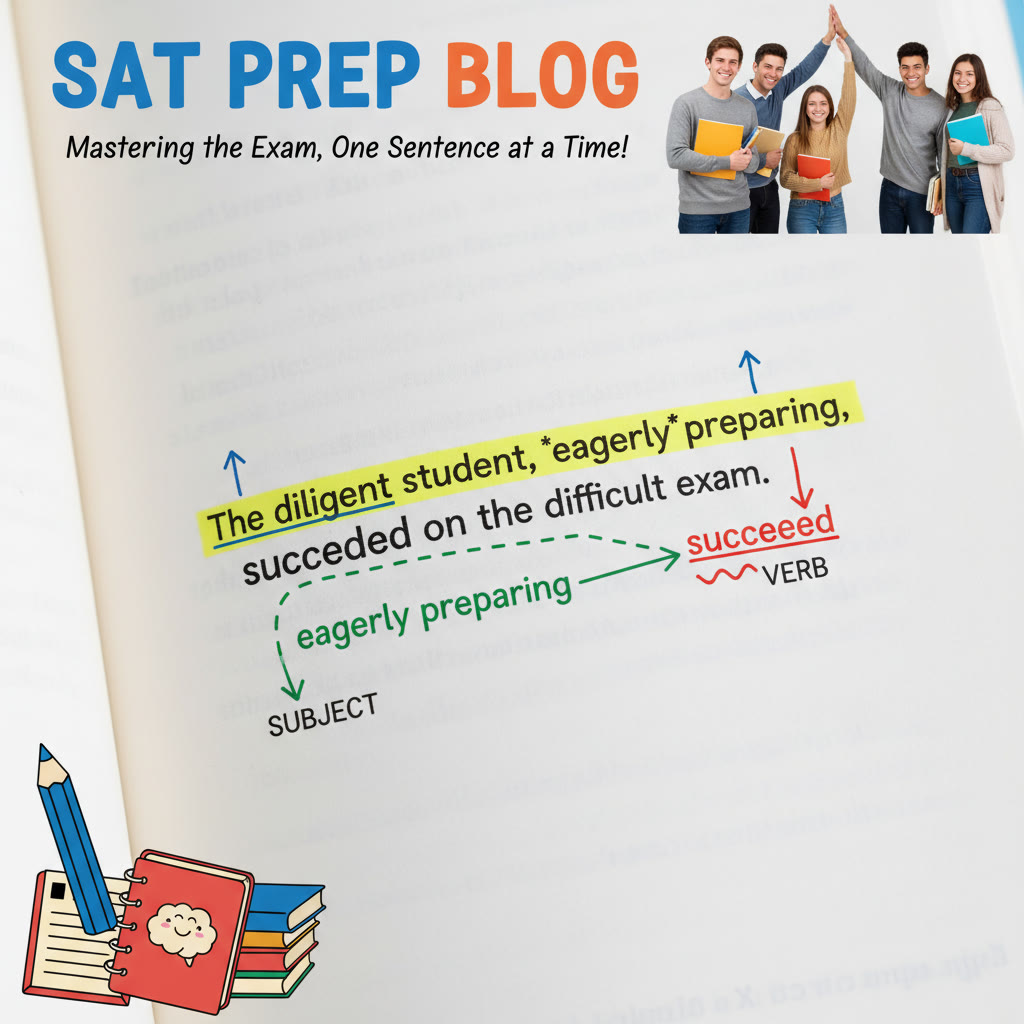Why sentence structure and syntax matter on the SAT (and in real life)
When you sit down for the SAT Writing section, you aren’t just being tested on rules. The test is measuring whether you can communicate clearly and efficiently—whether you can build sentences that deliver information in the simplest, most accurate way. Good sentence structure and correct syntax help you avoid ambiguity, tighten reasoning, and score higher on sentence-correction and passage-improvement questions.
Think of a sentence like a small machine: nouns are the parts, verbs are the motor, punctuation is the wiring, and syntax is the assembly manual. If any piece is out of place, the machine might sputter or break down. The SAT is almost allergic to sputter—every misaligned clause or dangling modifier is an invitation to lose points.

Big-picture categories of sentence problems you’ll see on the SAT
To attack sentence-level questions with confidence, it helps to group common errors. The SAT tends to reuse the same families of mistakes. Learn the pattern once, and you’ll recognize the problem quickly under time pressure.
- Sentence fragments and run-ons (including comma splices)
- Subject-verb agreement and nonparallel structure
- Modifier placement and dangling modifiers
- Misused pronouns and ambiguous references
- Faulty comparisons and mixed constructions
- Verb tense consistency and mood
- Punctuation that changes meaning (commas, semicolons, dashes)
Common traps, explained with patterns and examples
1. Fragments, run-ons, and comma splices
Fragment: a sentence that’s missing a subject, a verb, or a complete thought. Run-on: two complete sentences joined without the right connector or punctuation. Comma splice: a popular form of run-on where a comma tries to do the job of a stronger connector.
Example — Fragment:
Incorrect: “Because the experiment failed.” (What happened because it failed?)
Correct: “Because the experiment failed, the team redesigned the procedure.”
Example — Comma splice / run-on:
Incorrect: “The graph shows a steady rise, the authors attribute the increase to policy changes.”
Correct: “The graph shows a steady rise, and the authors attribute the increase to policy changes.”
Tip: If two independent clauses are side-by-side, look for a conjunction, semicolon, or separate them into two sentences.
2. Subject-verb agreement and tricky intervening phrases
Subjects must agree with verbs in number. The SAT loves to insert long prepositional phrases or interrupting clauses between subject and verb to distract you.
Example:
Incorrect: “The board, along with its advisers, were informed yesterday.”
Correct: “The board, along with its advisers, was informed yesterday.”
Tip: Isolate the subject and the verb. Ignore commas and parenthetical bits when deciding agreement.
3. Parallelism — keeping lists and comparisons balanced
Parallel structure means equivalent elements in a sentence should match grammatically. When the SAT asks you to choose between sentence options, the most parallel structure is often the right one.
Example:
Incorrect: “She likes hiking, to swim, and biking.”
Correct: “She likes hiking, swimming, and biking.”
Tip: Convert items into simple forms (gerunds, infinitives, or nouns) and check that each item follows the same pattern.
4. Misplaced and dangling modifiers
A modifier must clearly attach to the word it’s intended to modify. A modifier that’s too far from its target creates confusion or nonsense.
Example — Dangling modifier:
Incorrect: “Walking to campus, the rain started suddenly.” (This suggests the rain was walking.)
Correct: “Walking to campus, I was caught in a sudden rain.”
Tip: Ask: who or what is doing this action? Place the modifier next to that noun.
5. Pronoun clarity and agreement
Pronouns must clearly refer to a specific noun (their antecedent), and they must match in number and gender when required. Vague pronoun references are common traps.
Example:
Incorrect: “When the students met with the counselor, she suggested a plan.” (Who is ‘she’?)
Correct: “When the students met with the counselor, the counselor suggested a plan.”
Tip: If you can replace a pronoun with its noun without sounding repetitive and it becomes clearer, do it.
6. Faulty comparisons
Every comparison needs a clear and logical pair. The SAT objects to comparisons that leave the reader asking “compared to what?” or that compare unlike categories.
Example:
Incorrect: “Running a college is easier than managing a small business.” (Are we comparing ‘running’ to ‘managing’?)
Correct: “Running a college is easier than running a small business.”
Tip: Make both sides of the comparison match in grammatical form and category.
7. Verb tense and mood errors
Most SAT passages require consistency in tense unless there’s a clear reason to change. Signals like “by the time” or time markers often explain a shift; otherwise, keep the tense steady.
Example:
Incorrect: “She studies for years and then graduated.”
Correct: “She studied for years and then graduated.”
Tip: Spot the timeline. If the entire sentence talks about past events, use past tense verbs.
Short, practical strategies for speed and accuracy
When you’re under time pressure, adopt a consistent routine. Here are fast, reliable moves that help you avoid second-guessing and wasted seconds.
- Read the full sentence or sentence pair before looking at answer choices. The SAT often tests logic, not vocabulary.
- Identify the core subject and verb first. That forces agreement and highlights missing pieces.
- Circle or underline the part that seems off—comma, pronoun, or comparison—and answer that specific issue.
- Use process-of-elimination. Wrong answers often introduce new errors or change the meaning.
- If two answers mean the same thing, the shorter one is usually better (clarity and concision are favored).
A compact table: common errors, how to spot them, quick fix
| Error type | Spotting clues | Quick fix |
|---|---|---|
| Fragment | Starts with because/when/although and leaves idea incomplete | Add a subject/verb or attach to an adjacent sentence |
| Comma splice / run-on | Comma between two independent clauses | Replace comma with period/semicolon or add conjunction |
| Subject-verb disagreement | Long phrase between subject and verb | Isolate subject/verb and match number |
| Dangling modifier | Intro phrase with no clear subject | Move modifier or add the correct subject |
| Faulty comparison | Comparative word (than/as) without a parallel item | Make the compared items parallel |
| Vague pronoun | Pronoun with unclear antecedent | Replace pronoun with the noun or reword |
Walkthrough: a step-by-step example
Let’s take a typical SAT sentence and solve it together. Read it once, underline the part that sounds off, then test answers.
Question sentence: “Although the committee approved the revised guidelines, the new rules, which outlining several added safety measures, remains controversial.”
First, identify the core: subject + verb. The apparent subject is “the new rules,” but the verb shown is “remains.” Do they agree? “The new rules” is plural, so the verb should be plural (“remain”). Next, the clause “which outlining” looks wrong: “which” needs a verb, so it should be “which outline”.
Corrected: “Although the committee approved the revised guidelines, the new rules, which outline several added safety measures, remain controversial.”
Key moves we used: subject-verb agreement and correct verb form in a relative clause—two separate small problems that can coexist. The SAT sometimes layers errors like this, so always re-check the entire sentence after fixing one issue.
Practice approach: what to study and how much time to spend
Quality beats quantity. Here’s a focused study plan you can use over 4–6 weeks that balances drilling errors and building pattern recognition:
- Weeks 1–2: Fundamentals. Spend time on fragments, run-ons, subject-verb agreement, and parallelism. Do short drills (20–30 minutes) every day.
- Weeks 3–4: Complexity. Add modifier placement, pronoun clarity, and comparison errors. Practice with full SAT-style questions and timed sets (25–35 minutes).
- Weeks 5–6: Synthesis and timing. Take mixed, timed sections, review mistakes thoroughly, and focus on slow points until they’re automatic.
Short daily practice is more effective than sporadic marathon sessions. Mix accuracy-focused work with timed drills to build speed without sacrificing precision.
Smart tools and practice exercises (no fluff)
Here are practical drills you can do right away, with a brief explanation of why each helps.
- Targeted sentence correction sets: 10–15 varied items focused only on modifiers or only on comparisons. Why: isolates one pattern until it becomes obvious.
- Subject/verb isolation practice: rewrite complex sentences removing parenthetical phrases. Why: trains you to spot the true subject quickly.
- Parallelism conversion drills: turn lists into consistent grammatical forms (all gerunds, all infinitives). Why: makes parallelism feel mechanical.
- Backwards elimination: when stuck, eliminate answers that alter meaning or introduce grammar problems. Why: SAT wrong answers often add new faults.
How to practice under timed conditions
Simulate test pressure, but keep practice manageable. Time yourself for 25–35 minutes on a mixed writing-and-language set. After solving, spend double the time reviewing every mistake—don’t just mark it correct or wrong. Understanding the error is how you stop repeating it.
Review checklist:
- What was the specific error type?
- Why was the correct answer correct?
- Was there a faster way to see it? (subject/verb isolation, spotting a dangling modifier, etc.)
How personalized tutoring can accelerate improvement
Self-study can take you a long way, but targeted guidance often speeds progress. For students who want efficient gains, Sparkl’s personalized tutoring can fit naturally into a study plan. Here’s why a tailored approach helps:
- 1-on-1 guidance identifies the exact patterns you keep missing instead of giving you a generic worksheet.
- A tailored study plan focuses practice on your weakest error types—so you spend time where it matters most.
- Expert tutors model how to parse tough sentences quickly and explain logic in plain language.
- AI-driven insights can track how often you miss specific error types and adjust practice dynamically.
If you’ve been spinning your wheels on the same mistakes, a few sessions of personalized tutoring can turn a recurring 50/50 into a habit of near certainty. The key is not just practice, but smart practice—doing the right drills the right way.
Sample mini-practice set (with quick explanations)
Try these three short items. Don’t worry about time—focus on technique, then check the mini-explanations.
Item 1
Sentence: “After the debate, the finalists and their coach were counting the ballots in the conference room, which sat empty.”
Problem: Which does “which” modify? It seems to describe “the conference room,” but the clause feels awkward after the verb phrase.
Fix: Move the modifier closer or rephrase: “After the debate, the finalists and their coach, who were counting the ballots in the conference room, found it empty.”
Item 2
Sentence: “Neither the manager nor the employees wants to volunteer for the weekend shifts.”
Problem: Subjects joined by “neither…nor” follow the verb number of the nearer noun. “Employees” is plural, so the verb should be “want.”
Correct: “Neither the manager nor the employees want to volunteer for the weekend shifts.”
Item 3
Sentence: “The novel, praised for its intricate plot and vivid characters, were quickly adopted by book clubs.”
Problem: Subject-verb disagreement. “The novel” is singular; the verb must be singular as well.
Correct: “The novel, praised for its intricate plot and vivid characters, was quickly adopted by book clubs.”
Putting it all together on test day
On test day, your best friend is routine. Before you start, remind yourself: isolate, scan, eliminate. If you feel a freeze coming on, use a one-sentence checklist:
- Identify the main subject and verb.
- Check for comparisons and parallelism.
- Look for modifiers at the start or end of the sentence.
- Confirm pronoun clarity and tense consistency.
Trust the patterns you practiced. The SAT rarely invents brand-new grammar; it repackages familiar errors in different clothes. If you practiced the categories above until recognition is automatic, you’ll save time and avoid second-guessing.
Real-world payoff: why this matters beyond the SAT
Good sentence structure is a life skill. Clear writing helps in college essays, lab reports, scholarship applications, and professional emails. Every minute you spend polishing syntax on the SAT is an investment in communicating more persuasively in the future.

Final checklist and encouragement
Here’s a short checklist to carry through your final weeks of prep and into the test:
- Daily short drills (20–30 minutes) on one error type.
- Weekly timed section with detailed review of every mistake.
- Practice isolating subject and verb first on every sentence.
- Work with feedback: see why you missed each question and write a one-line rule to prevent repeats.
- Consider occasional 1-on-1 sessions if mistakes persist—personalized tutoring can accelerate correction and build confidence.
Sentence structure and syntax can feel intimidating at first because the SAT packs several traps into a single sentence. But once you learn the patterns—fragments, run-ons, modifiers, comparisons—the sentences become puzzles you can solve. With steady practice, a clear method, and the occasional targeted help from a tutor, you’ll move from uncertainty to steady, reliable answers.
Remember: accuracy first, then speed. Build the habit of reading to understand, not to guess. Your careful practice pays off on test day and in every piece of writing that matters after. Good luck—and enjoy the process of making your sentences sing.














No Comments
Leave a comment Cancel